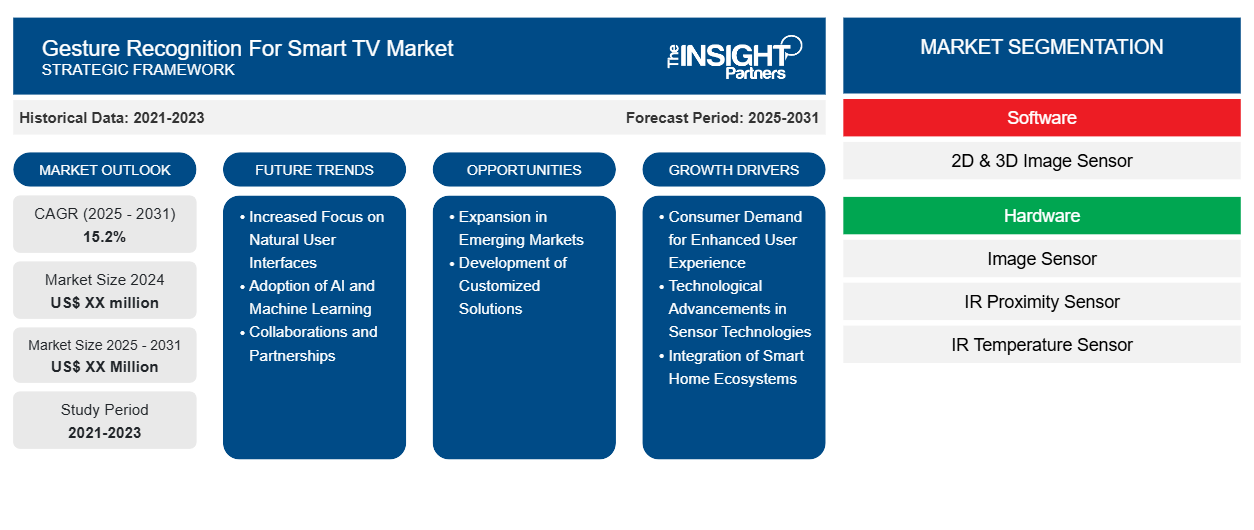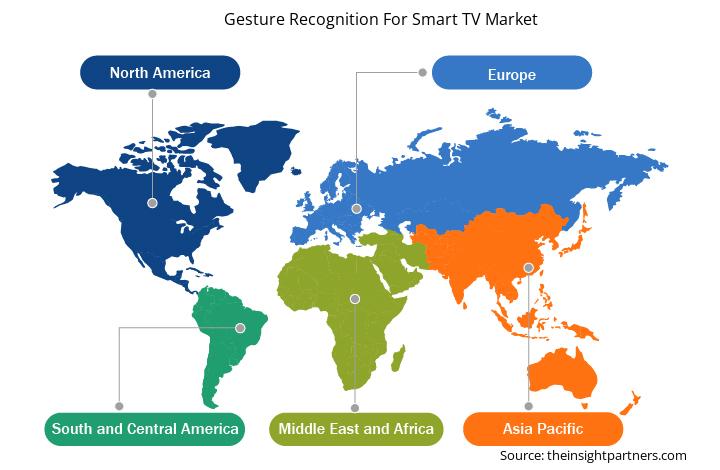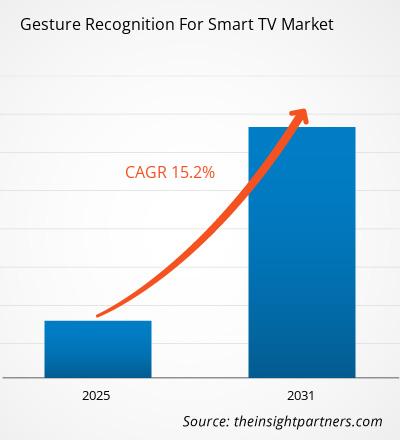智能电视手势识别市场预计在 2025 年至 2031 年期间的复合年增长率为 15.2%,市场规模将从 2024 年的 XX 百万美元扩大到 2031 年的 XX 百万美元。
报告按软件(2D 和 3D 图像传感器)、硬件(图像传感器、红外近距离传感器、红外温度传感器、光传感器和半导体 ICS)细分。全球分析进一步细分为区域和主要国家。报告以美元为单位提供上述分析和细分的价值。
报告目的
Insight Partners 发布的《智能电视手势识别市场》报告旨在描述当前形势和未来增长、主要驱动因素、挑战和机遇。这将为各种业务利益相关者提供见解,例如:
- 技术提供商/制造商:了解不断变化的市场动态并了解潜在的增长机会,从而能够做出明智的战略决策。
- 投资者:对市场增长率、市场财务预测以及整个价值链中存在的机会进行全面的趋势分析。
- 监管机构:监管市场政策和警察活动,旨在最大限度地减少滥用行为,维护投资者的信任和信心,维护市场的完整性和稳定性。
手势识别在智能电视市场细分中的应用
软件
- 2D 和 3D 图像传感器
硬件
- 图像传感器
- 红外接近传感器
- 红外温度传感器
- 光传感器
- & 半导体 ICS
定制此报告以满足您的需求
您可以免费定制任何报告,包括本报告的部分内容、国家级分析、Excel 数据包,以及为初创企业和大学提供优惠和折扣
智能电视市场的手势识别:战略洞察

- 获取此报告的关键市场趋势。这个免费样品将包括数据分析,从市场趋势到估计和预测。
手势识别是智能电视市场增长的驱动力
- 消费者对增强用户体验的需求:对直观和用户友好界面的需求不断增长,这是手势识别市场的主要驱动力。消费者正在寻求超越传统遥控器的与智能电视的无缝互动。基于手势的导航通过允许观众通过自然动作轻松控制其设备来增强用户体验。这种对更具吸引力和沉浸感的体验的需求正在推动制造商将手势识别技术集成到智能电视中。
- 传感器技术进步:深度传感器和摄像头等传感器技术的进步正在推动智能电视手势识别的发展。这些技术能够精确检测和解读用户手势,从而提高手势界面的响应能力和可靠性。随着传感器技术变得更加经济实惠和紧凑,制造商越来越多地将这些功能融入到他们的智能电视产品中,让消费者更容易获得手势识别。
- 智能家居生态系统的整合:智能家居整合的日益增长趋势是手势识别市场的重要驱动力。随着消费者采用互联智能设备,对通用控制机制的需求也在增加。手势识别让用户不仅能够控制电视,还能通过简单的手势控制其他智能家居设备。这种互操作性增强了配备手势识别功能的智能电视的吸引力,从而增加了技术娴熟的消费者对智能电视的接受度。
手势识别是智能电视市场未来趋势
- 更加注重自然用户界面:手势识别市场的一个突出趋势是转向自然用户界面 (NUI)。与传统输入方法相比,消费者更青睐允许更多自然交互(例如手势和身体动作)的系统。这一趋势促使制造商投资开发先进的手势识别算法,以准确解释各种自然动作,从而带来更直观的用户体验。
- 采用人工智能和机器学习:将人工智能 (AI) 和机器学习算法集成到手势识别系统中是一种日益增长的趋势。这些技术提高了手势识别的准确性和适应性,使设备能够从用户行为中学习并随着时间的推移提高响应能力。随着人工智能的不断发展,配备手势识别功能的智能电视将越来越能够理解复杂的手势并提供个性化的互动。
- 合作与伙伴关系:市场正在见证科技公司与内容提供商之间合作以增强手势识别能力的趋势。通过与软件开发商和硬件制造商合作,公司旨在创建可以集成到智能电视中的更复杂的手势识别系统。这些合作的重点是开发创新应用程序并通过基于手势的控制各种内容和服务来增强用户参与度。
手势识别为智能电视带来市场机遇
- 新兴市场的扩张:新兴市场为智能电视手势识别市场提供了重大机遇。随着可支配收入的增加和消费者偏好转向智能家居技术,对具有手势识别功能的高级智能电视的需求预计将增长。制造商可以利用这一趋势,推出配备手势识别功能的经济实惠的智能电视型号,以满足这些地区消费者的偏好。
- 开发定制解决方案:制造商有机会开发针对特定用户人口统计或偏好的定制手势识别解决方案。通过利用用户数据和反馈,公司可以创建适合不同年龄组、文化和生活方式的手势识别系统。这种个性化可以提高用户满意度并提高采用率,从而在市场上创造竞争优势。
智能电视手势识别市场区域洞察
Insight Partners 的分析师已详细解释了预测期内影响智能电视手势识别市场的区域趋势和因素。本节还讨论了智能电视手势识别市场的细分市场和地理位置,包括北美、欧洲、亚太地区、中东和非洲以及南美和中美洲。

- 获取智能电视市场手势识别的区域特定数据
智能电视手势识别市场报告范围
| 报告属性 | 细节 |
|---|---|
| 2024 年的市场规模 | XX 百万美元 |
| 2031 年市场规模 | XX 百万美元 |
| 全球复合年增长率(2025 - 2031) | 15.2% |
| 史料 | 2021-2023 |
| 预测期 | 2025-2031 |
| 涵盖的领域 | 按软件
|
| 覆盖地区和国家 | 北美
|
| 市场领导者和主要公司简介 |
|
智能电视手势识别市场参与者密度:了解其对业务动态的影响
智能电视手势识别市场正在快速增长,这得益于终端用户需求的不断增长,这些需求源于消费者偏好的不断变化、技术进步以及对产品优势的认识不断提高等因素。随着需求的增加,企业正在扩大其产品范围,进行创新以满足消费者的需求,并利用新兴趋势,从而进一步推动市场增长。
市场参与者密度是指在特定市场或行业内运营的企业或公司的分布情况。它表明在给定市场空间中,相对于其规模或总市场价值,有多少竞争对手(市场参与者)存在。
智能电视手势识别市场的主要公司有:
- 视力科技
- Leap Motion 公司
- LG 电子公司
- 松下公司
- 点抓有限公司
免责声明:上面列出的公司没有按照任何特定顺序排列。

- 了解智能电视手势识别市场的主要参与者概况
主要卖点
- 全面覆盖:报告全面涵盖了智能电视手势识别市场的产品、服务、类型和最终用户的分析,提供了整体概况。
- 专家分析:报告基于对行业专家和分析师的深入了解而编写。
- 最新信息:该报告涵盖了最新信息和数据趋势,确保了其与业务的相关性。
- 定制选项:此报告可以定制以满足特定客户要求并恰当地适应业务策略。
因此,智能电视手势识别市场研究报告有助于引领解读和了解行业情景和增长前景。尽管可能存在一些合理的担忧,但本报告的总体优势往往大于劣势。
- 历史分析(2 年)、基准年、预测(7 年)及复合年增长率
- PEST和SWOT分析
- 市场规模、价值/数量 - 全球、区域、国家
- 行业和竞争格局
- Excel 数据集
近期报告
相关报告
客户评价
购买理由
- 明智的决策
- 了解市场动态
- 竞争分析
- 客户洞察
- 市场预测
- 风险规避
- 战略规划
- 投资论证
- 识别新兴市场
- 优化营销策略
- 提升运营效率
- 顺应监管趋势




















 获取免费样品 - 智能电视市场的手势识别
获取免费样品 - 智能电视市场的手势识别